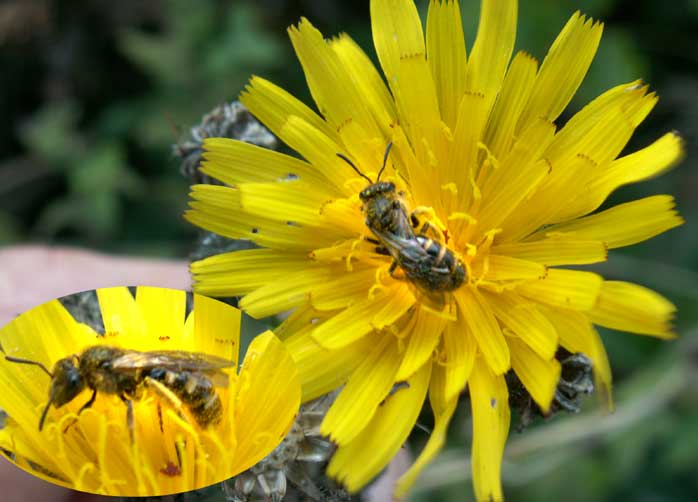 |
 |
 |
 |
 |
 |
Three
medium-sized
Yellow-footed
Solitary Bee, Lasioglossum
xanthopum, visited the flowers of
the Musk Thistles on
the cleared patch on the lower slopes of Mill
Hill.
 |
Lasioglossum xanthopum, on a Musk Thistle |
 |
 |
14
April 2009
This small bee was spotted at the extreme southern end of the Coastal Link Cyclepath. It
is an Andrena
species.
Suggested
ID by Stuart Roberts
Common
Andrena
web page |
| 14
April 2007
Three Red Mason Bees visited my garden in residential Shoreham. |
| 10
April 2007
There was a lot of buzzing in my front garden in residential Shoreham, with my first female Spring (Hairy-footed) Flower Bee of the year that visited the flowering Rosemany and exceeded the buzzing of the queen Buff-tailed Bumblebee which buzzed around elsewhere. The black tongue could be seen clearly on the Spring (Hairy-footed) Flower Bee. |
 |
| 9
April 2007
This Andrena bee was seen on an Alexander on the southern part of Mill Hill. |
 |
 |
 |
This is surely a species of the mining bee of the Andrena genus, of solitary bees that often live together.
To be precise it is a female Andrena dorsata. This is a common species which has both a spring and summer generation. Note the extremely short hair fringe on the dorsal margin of the hind tibia. This character plus the almost fully enclosed propodeal floccus (pouch) are diagnostic for the female of this species.
26
April 2006
 |
 |
6
April 2006
This looks like a tiny bee on a Daisy. There were probably at least two more on a Dandelion in the middle Triangle area of Mill Hill. Could it be Lasioglossum albipes |
 |
This was probably a male of the species of Lasioglossum, most likely Lasioglossum calceatum. ID to genus confirmed and to species and gender suggested by Philippe Moniotte on the British Insects (Yahoo Group) |
 |
This is a common eusocial
species, polylectic (pollen generalists) and ground nesting.
Lasioglossum
List
17
April 2005
The
Spring
(Hairy-footed) Flower Bee* with
a long tonque and a loud buzzing sound in
a Shoreham garden, was misidentified as a
bee-fly at first. It was not a fly at
all, but a solitary bee called Anthophora
plumipes. It is a female (they are black) and the males are
brown.
The
straightforward conclusion is the intruder with which it appeared to be
fighting was the male of the same species and they were mating.
 |
 |
 |
Image:
Left
A Yellow-footed Solitary Bee, Lasioglossum xanthopum, about to take flight from a Hardhead on the middle slopes of Mill Hill, just above the lower slopes. Image:
Right
|
 |
17
October 2005
A
Yellow-footed
Solitary Bee*, Lasioglossum
xanthopum, visited a Stemless
Thistle, one of very few plants remaining
in flower.
(*
ID
not confirmed, but likely). This was a large Lasioglossum.
Adur
Solitary Bees
28
October 2004
After
heavy rain yesterday, the Lasioglossum
solitary
bee was still attracted to the Devil's Bit
Scabious on the lower
slopes of
Mill
Hill. (TQ
209 074) I declined to collect this specimen
for examination as there seemed to be only one.
 |
 |
 |
In
the absence of identification to species level, I have christened this
one as the Zebra Lasioglossum
and
the scientific species name will have to wait until I can find a book with
the identification features. It is was a reasonably obliging insect which
could be examined moving around under a magnifying glass. From the side
view I noticed the black abdomen underneath the black and white stripes.
Alas, the camera was not functioning very well and the images were not
as a good as I would have liked. Clicking
on the images will enlarge them.
There
are
31 species of Lasioglossum
found
in Britain, although some of these are rare and only found in a few locations.
The solitary bee is Lasioglossum xanthopum - the largest British species of the genus, with males that peak much later than any other species (typically late September/early October - we are still trying to work out how it mates as you rarely see females at this time of year). It is a rather calcicolous species and frequent on the Sussex downs, though I have never surveyed these late enough to see males. It is graded Nationally Scarce at the moment. It can be confused for the similar Halictus rubicundus (slightly smaller with abdominal dust spots at the apices of the tergites as opposed to the bases like your photo).
The
consensus on the British
Insects (Yahoo Group) is that this small bee is a species of Lasioglossum,
and
not a Colletes, but the species is unlikely to be identified by
a photograph (I did not think it was anything special when I photographed
it).
 |
  |
Lasioglossum
albipes
Lasioglossum
angusticeps
Lasioglossum
brevicorne
Lasioglossum
calceatum
Lasioglossum
cupromicans
Lasioglossum
fratellum
Lasioglossum
fulvicorne
Lasioglossum
laeve
Lasioglossum
laevigatum
Lasioglossum
laticeps
Lasioglossum
lativentre
Lasioglossum
leucopus
Lasioglossum
leucozonium
Lasioglossum
limbellum
Lasioglossum
malachurum
Lasioglossum
minutissimum
Lasioglossum
morio
Lasioglossum
nitidiusculum
Lasioglossum
parvulum
Lasioglossum
pauperatum
Lasioglossum
pauxillum
Lasioglossum
prasinum
Lasioglossum
punctatissimum
Lasioglossum
puncticolle
Lasioglossum
quadrinotatum
Lasioglossum
rufitarse
Lasioglossum
semilucens
Lasioglossum
sexnotatum
Lasioglossum
smeathmanellum
Lasioglossum
villosulum
Lasioglossum
xanthopus
Lasioglossum
zonulum
Garden Solitary Bees (External Link)
Bumblebees
Hoverflies
Butterflies
Solitary
Bees
Adur
Bees, Wasps & Sawflies
Bees
and Wasps
Flies
Beetles
Moths
Grasshoppers
& Crickets
Damselflies
&
Dragonflies